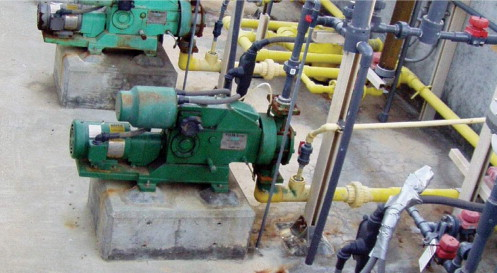
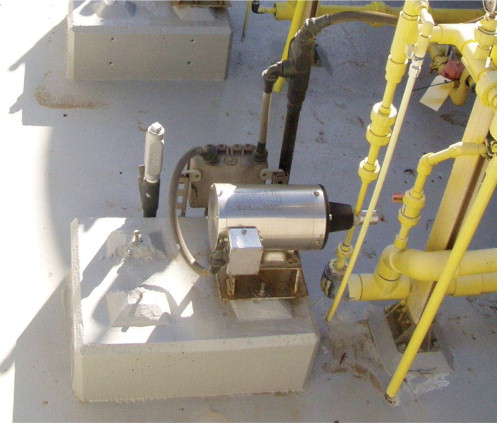
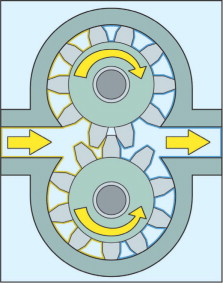
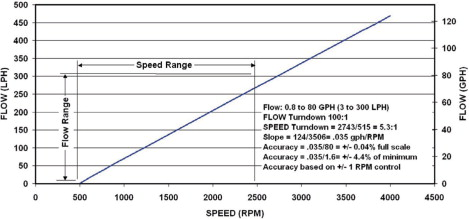
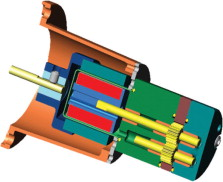
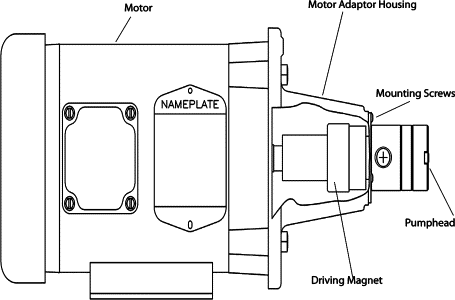
Vallejo Sanitation and Flood Control District, Vallejo, California USA is a 60 MGD wastewater treatment facility. Vallejo Sanitation has used magnetically coupled external gear pumps to meter 12.5% sodium hypochlorite since 2003. The compact magnetically coupled external gear pumps easily replaced the typical diaphragm type metering pumps. The non-pulsing magnetically coupled external gear pumps eliminated vapor locking, eliminated the pulsation dampener, reduced maintenance downtime, reduced maintenance costs, and reduced chemical usage.
Fluctuations
Vallejo Sanitation can fluctuate from less than 10 MGD in the dry season to over 60 MGD in the wet season due to storm water intrusion. They switched from Chlorine gas disinfectant to Ultraviolet (UV) Light in 1996. A 12.5% sodium hypochlorite disinfection system was installed as a backup and for flows above 31 MGD. Above 31 MGD, the turbidity caused the UV light to become ineffective. In 2000 the energy costs increased to the point the UV system became very expensive to operate. To reduce costs, Vallejo Sanitation changed the sodium hypochlorite system to primary and the UV system became the backup.
Unlike gaseous chlorine and UV systems, the sodium hypochlorite system required the use of metering pumps to complete the injection process. The system was designed to use existing diaphragm metering pump technology. The diaphragm pumps had been used for metering wastewater treatment chemicals since their invention in the 1920's. At the time, the company did not realize that sodium hypochlorite is not a typical metering application.
After switching to sodium hypochlorite, Vallejo Sanitation experienced several problems. The extreme change in demand for chemical treatment between the wet and dry seasons placed heavy demand on the pump turndown ratio requirements. As a result, the district added variable speed motors to their variable stroke diaphragm pumps to enhance turndown capabilities. When demand was very low, there was no way to know whether the pumps were producing sufficient flow due to the slow stroke rate. The diaphragm pump pulsations made it difficult to achieve a real time flowmeter feedback. To ensure adequate chemical injection, the flow rate was increased, injecting more sodium hypochlorite than necessary.
Catastrophic
There lead to an even more catastrophic problem. The diaphragm pumps contain valves trapping the liquid sodium hypochlorite. Since sodium hypochlorite gasses off, these valves also trapped vapor. The compressible vapor, when compressed by the diaphragms, would not build enough pressure to open the valves. This resulted in vapor locking and loss of flow. Without flow, they could not inject sodium hypochlorite into the water. To restart the chemical injection process they had to bleed the chlorine vapors to prime the pumps.
During a plant tour of another facility, Doug Boss, electrical maintenance foreman, Vallejo Sanitation, observed a magnetically coupled external gear pump metering sodium bisulphite. The external gear pump had replaced a diaphragm metering pump and was performing well. This inspired him to try an external gear pump as a possible solution for sodium hypochlorite. The magnetically coupled external gear pump and motor assembly was approximately 80% less weight and 1/3 the length of a typical diaphragm type pump.
Vallejo Sanitation sodium hypochlorite metering requirements are 1 gph up to 80 gph at 60 psi differential pressure. They installed a 2.3 ml/revolution magnetically coupled external gear metering pump with hastelloy construction and with PEEK gears and bearings and Viton O-ring static seals. The pump and motor assembly was so compact, it required only a small portion of the original pedestal designed for a diaphragm pump. It was powered by a three phase motor connected to a variable frequency inverter drive. A flow meter was installed downstream with a signal feedback to the SCADA system that sent a following signal to the variable frequency drive to adjust the speed of the pump. The piping connections were completed with tubing and the pulsation dampeners were removed. Since the original installation in 2003, they have experienced no vapor locking. The pumps handle the extensive turn down flawlessly. They have now replaced the three primary sodium hypochlorite pumps with magnetically coupled external gear pumps (Figure 2).
Magnetically coupled external gear pumps are a positive displacement valveless design that operates at motor speeds. They are constructed of 316 stainless steel, hastelloy or titanium providing chemical and corrosion resistance. The fluid is trapped in the gear teeth (Figure 3) and moved in large segments around the outside of the gear. The large fluid segments combined with low fluid velocities result in low NPSHR and low shear allowing the magnetically coupled external gear technology to effectively pump all types of chemicals including shear sensitive polymers. This positive displacement design uses standard motors and speed controllers while providing excellent metering accuracies, better than 1%. The valveless external gear pump design allows some slippage of fluid past the gears and bearings known as ‘slip’ and can provide turn down ratios greater than 100:1 with a standard non-inverter duty AC motor and inverter drive. This exceptional turn down ratio is the result of the flatter performance curve slope due to the fluid slip. Figure 4 shows the estimated metering performance of the Tuthill magnetically coupled external gear pump used by Vallejo Sanitation for 12.5% sodium hypochlorite.
Standard motors
Vallejo Sanitation is able to use standard motors and variable frequency inverter drives to achieve a 100:1 flow turndown ratio. The Tuthill magnetically coupled external gear pump estimated operating speeds to realize the Vallejo Sanitation performance requirements are 515 to 2743 rpm or a 5.3:1 rpm turndown. A typical 4-pole motor is rated for continuous duty service from 450 to 5000 rpm when controlled by a variable frequency inverter drive. The Tuthill magnetically coupled external gear pumps have no minimum rating and are rated up to 4000 or 5000 rpm maximum depending on the model.
The magnetically coupled external gear pump used by Vallejo Sanitation is a seal-less technology (Figure 5). The two gear assemblies are the only moving parts. Combined with five bearings, the external gear pump can operate for as much as 20,000 hours on water before requiring service. The long life design maintains calibration for extended periods of time. An external gear pump is easily serviced by installing new gears, bearings, and o-rings. A service kit for an external gear pump is approximately 12 to 25% of the cost of a new pump head and can be installed in minutes. Systems with external gear pumps typically require very little pump maintenance, reducing the overall maintenance cost. Due to the long pump life and low parts costs, Vallejo Sanitation schedules the installation of a repair kit during regularly scheduled pump down time as part of their preventative maintenance.
Vallejo Sanitation discovered more benefits from the magnetically coupled external gear pump. Even though the pump head can be repaired while installed on the motor, it became evident they could replace a pump head in less time than it takes to do the safety lockout procedure. Since the magnetic coupling does not contact the motor shaft, the pump head is easily removed from the motor housing by removing a few screws. The 10 gpm (38 lpm) highest displacement magnetically coupled external gear pumphead weighs only 7 lb (3.2 kg) and the Vallejo Sanitation 2 gpm pumphead weighs only 2 lb (0.9 kg). The new pump head is installed by placing it into the motor housing (figure 6) and reinstalling the screws. There is a dowel that self aligns the pump head eliminating the possibility of misalignment. This was a substantial timesaving over the repair of the original diaphragm pump.
Conclusion
Vallejo Sanitation has used magnetically coupled external gear pumps to meter sodium hypochlorite since 2003. The valveless external gear pump design eliminated vapor locking from out gassing sodium hypochlorite. The positive displacement self priming external gear pump provides smooth non-pulsing flow eliminating the need for pulsation dampeners. The smooth flow was compatible with a flow meter providing very accurate sodium hypochlorite injection, which has reduced their sodium hypochlorite and sodium bisulphite chemical usage. The magnetically coupled external gear pump long life allowed Vallejo Sanitation to schedule the pump maintenance during scheduled down time. The simple design and compact size was quickly and easily repaired or replaced on-site. The compact size simplifies the installation process and provides more location options. Since an external gear pump operates at motor speeds they use standard motors and controllers.
In addition, Vallejo Sanitation has experienced an overall cost reduction from low initial costs, reduced chemical usage, and reduced maintenance cost by using magnetically coupled external gear pumps. Vallejo Sanitation plans to continue the move away from diaphragm type pumps to magnetically coupled external gear metering pumps. The magnetically coupled external gear pump is an effective metering technology for water and wastewater chemical metering applications.
Customer profile
The Vallejo Sanitation & Flood Control District is an independent special district created by the State of California to collect and treat wastewater, and protect the Vallejo community from flooding. Since 1952, the District has protected public health and the San Francisco Bay by collecting and treating the wastewater generated by more than 115,000 residents of Vallejo and the surrounding area. In addition, the District helps save lives and protects property from storm water damage.





